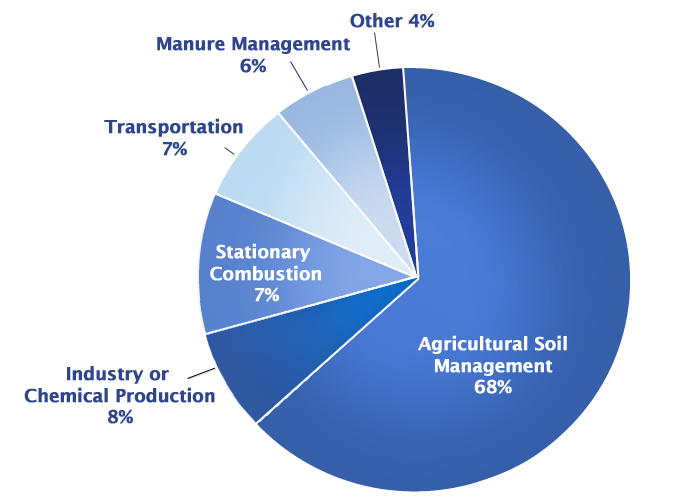Climate Change
Greenhouse Gas Emissions
Nitrous Oxide Emissions

| Chemical Formula | N2O |
| Lifetime in Atmosphere | 120 years |
| Global Warming Potential (100-year) | 310 |
U.S. Nitrous Oxide Emissions, By Source

Note: All emission estimates from the Inventory of U.S. Greenhouse Gas Emissions and Sinks: 1990-2010.
In 2010, nitrous oxide (N2O) accounted for about 4% of all U.S. greenhouse gas emissions from human activities. Nitrous oxide is naturally present in the atmosphere as part of the Earth's nitrogen cycle, and has a variety of natural sources. However, human activities such as agriculture, fossil fuel combustion, wastewater management, and industrial processes are increasing the amount of N2O in the atmosphere. Nitrous oxide molecules stay in the atmosphere for an average of 120 years before being removed by a sink or destroyed through chemical reactions. The impact of 1 pound of N2O on warming the atmosphere is over 300 times that of 1 pound of carbon dioxide.
Globally, about 40% of total N2O emissions come from human activities. [1] Nitrous oxide is emitted from agriculture, transportation, and industry activities, described below.
- Agriculture. Nitrous oxide is emitted when people add nitrogen to the soil through the use of synthetic fertilizers. Agricultural soil management is the largest source of N2O emissions in the United States, accounting for about 68% of total U.S. N2O emissions in 2010. Nitrous oxide is also emitted during the breakdown of nitrogen in livestock manure and urine, which contributed to 6% of N2O emissions in 2010.
- Transportation. Nitrous oxide is emitted when transportation fuels are burned. Motor vehicles, including passenger cars and trucks, are the primary source of N2O emissions from transportation. The amount of N2O emitted from transportation depends on the type of fuel and vehicle technology, maintenance, and operating practices.
- Industry. Nitrous oxide is generated as a byproduct during the production of nitric acid, which is used to make synthetic commercial fertilizer, and in the production of adipic acid, which is used to make fibers, like nylon, and other synthetic products.
Nitrous oxide emissions occur naturally through many sources associated with the nitrogen cycle, which is the natural circulation of nitrogen among the atmosphere, plants, animals, and microorganisms that live in soil and water. Nitrogen takes on a variety of chemical forms throughout the nitrogen cycle, including N2O. Natural emissions of N2O are mainly from bacteria breaking down nitrogen in soils and the oceans. Nitrous oxide is removed from the atmosphere when it is absorbed by certain types of bacteria or destroyed by ultraviolet radiation or chemical reactions.
To find out more about the role of N2O in warming the atmosphere and its sources, visit the Causes of Climate Change page and the Greenhouse Gas Indicators page in the Science section.
Emissions and Trends
Nitrous oxide (N2O) emissions in the United States have decreased by about 3% between 1990 and 2010. This decrease in emissions is due in part to advances in vehicle emissions control technologies and the widespread installation of pollution control measures in the production of adipic acid. Nitrous oxide emissions from agricultural soils have varied during this period and were about 4% higher in 2010 than in 1990.
Going forward, N2O emissions are projected to increase by 5% between 2005 and 2020, driven largely by increases in emissions from agricultural activities. [2]
U.S. Nitrous Oxide Emissions, 1990-2010

Note: All emission estimates from the Inventory of U.S. Greenhouse Gas Emissions and Sinks: 1990-2010.
Reducing Nitrous Oxide Emissions
There are a number of ways to reduce emissions of nitrous oxide (N2O), discussed below.
| Emissions Source | Examples of How Emissions Can be Reduced |
|---|---|
|
Agriculture |
The application of fertilizers accounts for the majority of N2O emissions. Emissions can be reduced by reducing nitrogen-based fertilizer applications and applying fertilizers more efficiently, [3] as well as following better manure management practices. |
|
Transportation |
|
|
Industry |
|
References
1. EPA (2010). Methane and Nitrous Oxide Emissions from Natural Sources (PDF). U.S. Environmental Protection Agency, Washington, DC, USA.
2. U.S. Department of State (2007). Projected Greenhouse Gas Emissions. In: Fourth Climate Action Report to the UN Framework Convention on Climate Change . U.S. Department of State, Washington, DC, USA.
3. EPA (2005). Greenhouse Gas Mitigation Potential in U.S. Forestry and Agriculture . U.S. Environmental Protection Agency, Washington, DC, USA.

